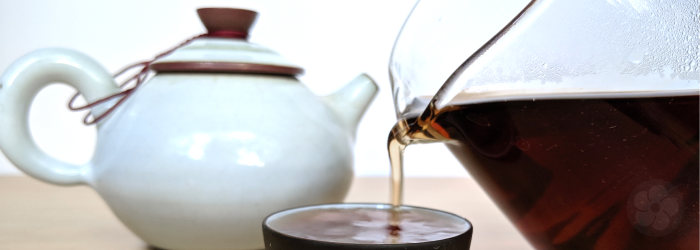Types of Pu-erh: Wet vs. Dry Storage

Pu-erh can be one of the most complex categories of tea, thanks to the infinite flavor variations that can develop during the process of fermentation and aging. Two pu-erhs identical in provenance, variety, harvest date and craftsmanship can still diverge during the aging process to become utterly unique teas.
Many aspects of the storage environment can ultimately change the character of the final fermented tea, and details of past storage can be obscured over time as these teas move through the market. One of the most important considerations is environmental humidity, which is often summarized in the terms “wet” and “dry”. But as with most simple distinctions, these terms can be misleading.

Wet vs. Dry Storage
Today, with the growing popularity of pu-erh, the distinction between wet and dry storage is typically associated with natural variations in climate. The difference between the ‘wet’ storage of Hong Kong on the coast and the ‘dry’ storage of Kunming in central Yunnan is commonly cited, but these two examples actually represent a very narrow range of potential storage conditions.
In fact, the most traditional ‘wet’ storage in Hong Kong required additional moisture to be added to the storage room in order to speed fermentation. This might be considered a precursor to the more modern accelerated fermentation used to make shou pu-erh, but the extreme conditions inevitably resulted in some loss to mold, even with careful rotation to improve airflow.

Modern pu-erh collectors around the world are also stretching the definition of ‘dry’ storage in climates much colder and drier than tropical southern China. Since cooler temperatures and lower humidity slow the fermentation process, pu-erh teas can take twice as long to ripen in our San Francisco warehouse as they do in Kunming or Guangdong.
Ultimately, environmental humidity is difficult to measure in absolute terms, limiting our understanding to generalizations like these. Measures of humidity are typically relative to temperature, and climate control like air conditioning or heat may also change the humidity indoors. Many pu-erh lovers invest in humidity-controlled storage boxes to ensure full control over their aging teas.

Flavor Variations
Despite the vague definition of this dichotomy, there are a few general truths about the way humidity affects flavor. Storage in hot, humid conditions increases the rate of microbial activity, causing the tea to become dark, rich, and peaty over a relatively short period of time. In contrast, cool, dry storage results in crisp, sweet flavors that take longer to develop.
Extremes on either end of the storage spectrum can also disrupt the aging process. As mentioned, added moisture to the air can create an environment perfect for mold growth. While some types of mold are actually valued among pu-erh experts, others can be dangerous. On the other end of the spectrum, a climate that is too dry can kill off microbial activity altogether, leaving a pu-erh raw, green, and bitter with no potential to develop into the dark, smooth tea that might otherwise be expected.

Given the range of possible results, we don’t often recommend that casual pu-erh drinkers buy teas for the express purpose of aging. While these teas do improve with age, it takes expertise and experience to recognize the signs of a tea that will age well and ensure that it reaches its full potential. Even the best aging conditions will not turn a bad tea into a good one, since the foundation of flavor still lie in the familiar factors of provenance, variety, harvest date, and craftsmanship. Instead, we suggest purchasing teas that can be appreciated at their present stage, and enjoying any advancement in flavor as an added bonus.
Have you tasted pu-erhs from different storage environments? Let us know what flavor impact you noticed in the comments below!



Comments on this post (0)